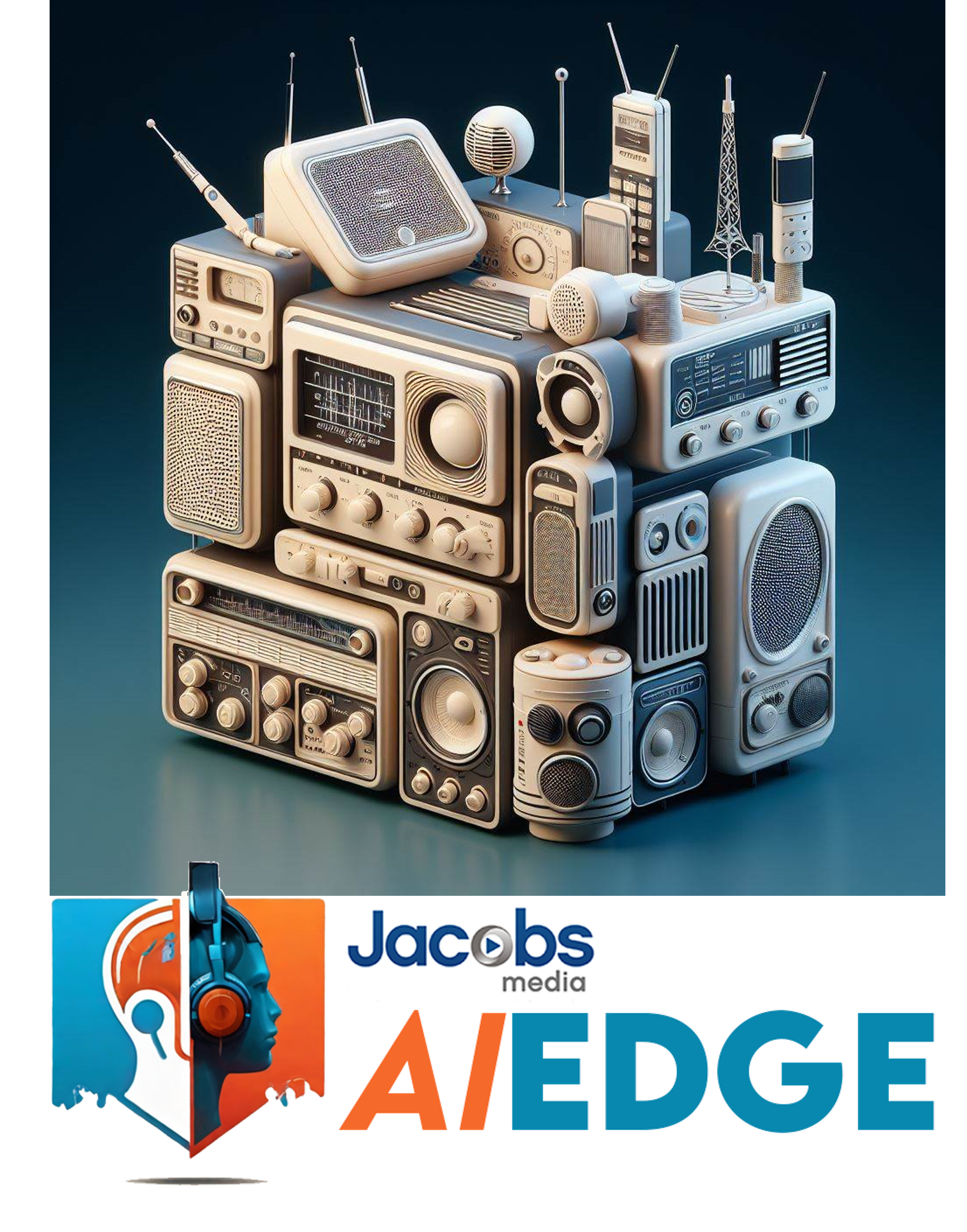
It’s official! We are newsletter publishers.
It has been clear in our research – especially our Public Radio Techsurveys – that newsletters are highly consumed by listeners who love these stations. We’ve been measuring newsletter readership for a few years now, and we continue to see them grow in popularity. No wonder that so many public radio stations and organizations have gone all-in on newsletters. In fact, more and more stations are publishing several during the course of the week.
And not a moment too soon. There is a “Breaking News” story – or five – every single day. This morning Axios reported on a new feature by OpenAI’s Sora that creates realistic videos with simple word prompts.
This video was made with these 18 words:
“Photorealistic closeup video of two pirate ships battling each other as they sail inside a cup of coffee.”
Amazing. But what’s the relevance?
There’s growing concern – and well-placed – that AI tools can instantly create deepfakes. Now, video has gotten even easier and more realistic, thanks to Sora. And Meta, Google, and others have announced/launched their proprietary text-to-video AI platforms.
Consumers are already freaked out by AI’s ability to disrupt the 2024 elections. You may recall President Biden’s fake AI voice was used in a Robocall in the New Hampshire primary urging Democrats not to bother to vote. Who knows how many received the message or believed it?
May we live in AInteresting times.
As you can see from our latest PRTS study, citizens are very wary of the technology and its ability to change minds – and votes.

In radio, the potential effects of AI might not be as dire, but they are most certainly worthy of our attention. Who’s doing what and with what tools should be on the radar screens of every personality, programmer, marketer, salesperson, and CEO in and around the industry.
There is massive interest in actionable information that can help organizations grow, while also improving skills among employees. Former Jacobs consultant, Andy Bloom, sent me an email offering AI support info and webinars. Look how many people had signed up for this webinar a few days before it took place.
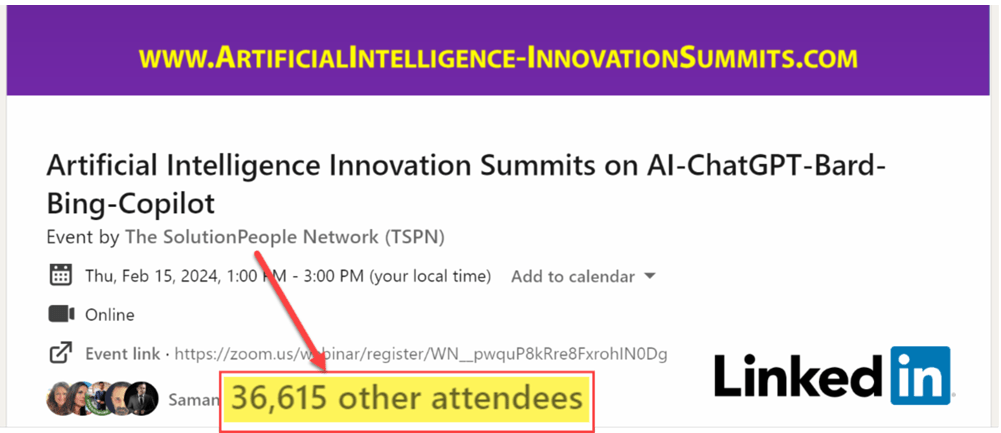
Thus, AI Edge, a weekly newsletter designed to help broadcasters navigate the in’s and out’s of AI.
The beauty of newsletters is they can hyper-focus – on areas of interest, geographies and neighborhoods, and even going inside on shows and programs themselves. They are easy to consume – on our phones, tablets, and laptops, and desktops.
interest, geographies and neighborhoods, and even going inside on shows and programs themselves. They are easy to consume – on our phones, tablets, and laptops, and desktops.
But one of the real bonuses is that while newsletters let us connect with listeners deeper than what most stations can do over the air, they also “digitize the audience.” That is, listeners sign up for the newsletter with an email address, and stations build their database, a key asset in their digital arsenals that they “own” – and not “rent.” That’s an important distinction over social media fans and followers, always having to play by the rule book of oligarchs like Elon Musk or Mark Zuckerberg.
And when we A:B:C compare podcasts to online games (like Wordle) to newsletters, it reveals fascinating audience consumption patterns:
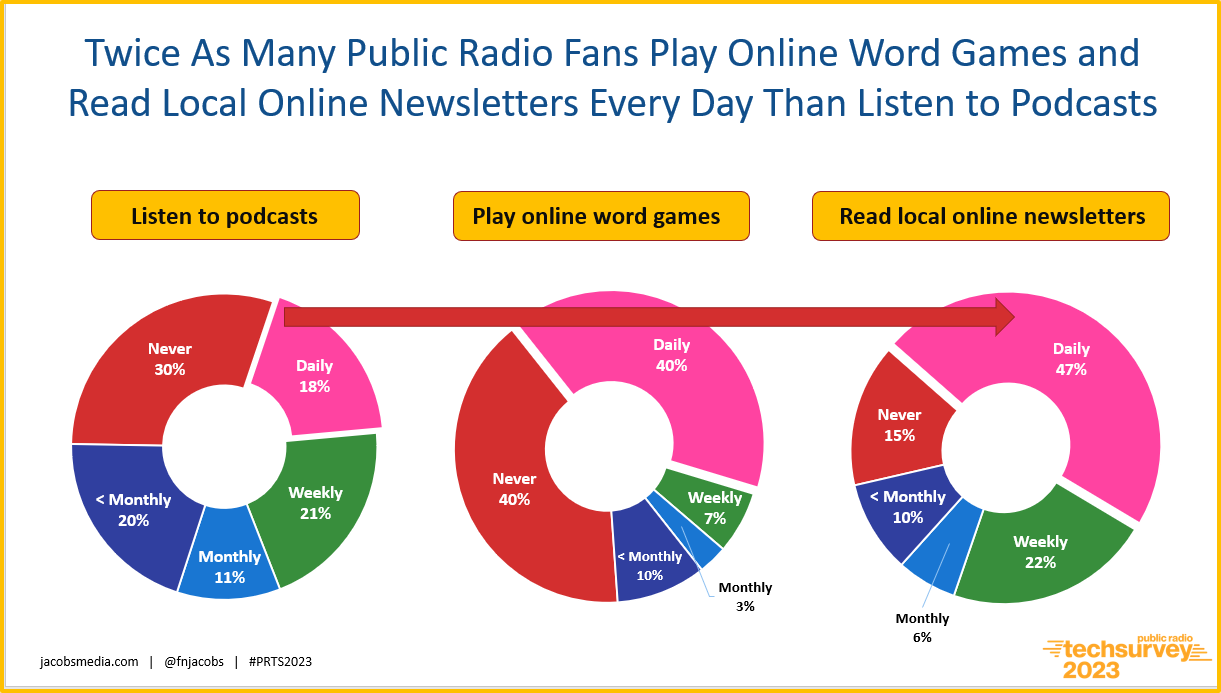
The daily readership slice of these pies tell us all we need to know. When nearly half (47%) of public radio core listeners read a local online newsletter every day, it’s a habit radio needs to tap into.
And not just public radio stations. Commercial and Christian stations would serve their respective audiences well by launching themed newsletters of interest. Your database holds the key – a simple survey among your email membership will reveal areas of opportunity in 48 hours. And you don’t need to hire someone like Larry Rosin, Jon Coleman, Carolyn Gilbert, or me to find out these basic answers.
Did I mention newsletters are highly sponsorable, offering a regular, well-defined audience to smart and savvy marketers, retailers, underwriters, and sponsors? In these revenue challenged times, that’s a benefit as well.
While most public radio stations are nodding their way through this post, I’m hoping commercial stations wake up and smell the opportunity. From my random searching across the country, in both big and small markets, newsletters for commercial music stations, in particular, are few and far between. That’s a sure sign radio is leaving audience, ad dollars, lots of email addresses, and branding opportunities on the table.
A shining exception (and, yes, there are others) is Beasley’s Country 103.7 in Charlotte. As they say, it covers local happenings, concert news and pre-sales, contests and giveaways, photos and videos, and discounts from station sponsors.
Here’s a quick promo video the station produced to stimulate newsletter signups:
Compared to dreaming up, launching, sustaining, and marketing a podcast (ask anyone who’s doing or done one), newsletters are a breeze. Or so I used to think.
When our newest member of the Jacobs Media team, Chris Brunt, came to us with the idea of AI Edge, a newsletter about Artificial Intelligence for broadcasters, we immediately green-lighted the idea. But after watching Chris go through the process of design, editorial, content creation, material aggregation, and marketing, I have much more respect for what it takes to do these so they’re readable, relevant, and real-time – our 3 R’s.
It would be one thing if our newsletter highlighted “this week in Rock,” a relatively finite topic that is easily searchable and structured with AI tools like ChatGPT. But because it’s about AI A-to-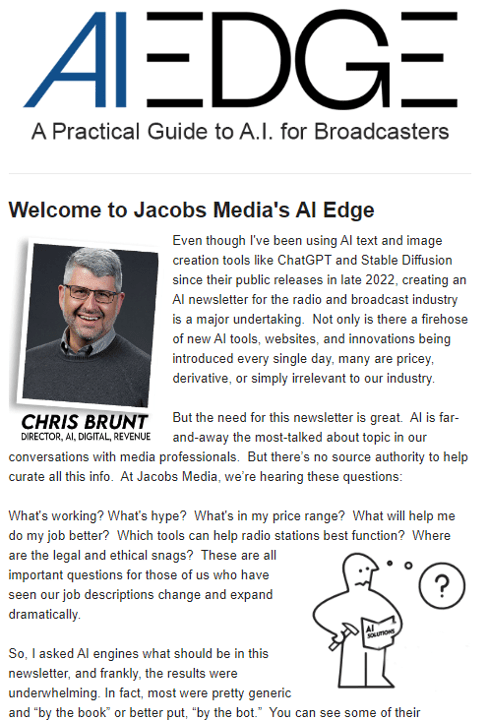 Z with a practical sense of what broadcasters need to know, it’s more of an undertaking and a challenge. In Chris’ statement of purpose at the beginning of AI Edge’s first issue, he notes:
Z with a practical sense of what broadcasters need to know, it’s more of an undertaking and a challenge. In Chris’ statement of purpose at the beginning of AI Edge’s first issue, he notes:
“Not only is there a firehose of new AI tools, websites, and innovations being introduced every single day, many are pricey, derivative, or simply irrelevant to our industry.”
Chris can curate this stuff for you, and act as your AI Sherpa to help you navigate this fast-moving space. Let him keep up with the changes coming at us daily.
On the one hand, most radio people are too damn busy to sift, vet, and consume this material. But on the other, acquiring AI skills, hacks, and innovations makes everyone’s job easier – especially the 20% (or so) of tasks we least enjoy doing.
Freshly returned from our journey to CES 2024, Chris spent the better part of four days on “AI patrol.” And it was time well spent.
If you attended our CES 2024 webinar last week, you watched Chris break down 10 of the best uses of AI we’ve seen. (He had a list of another dozen innovations, but we didn’t have time to show them all.)
My favorite?
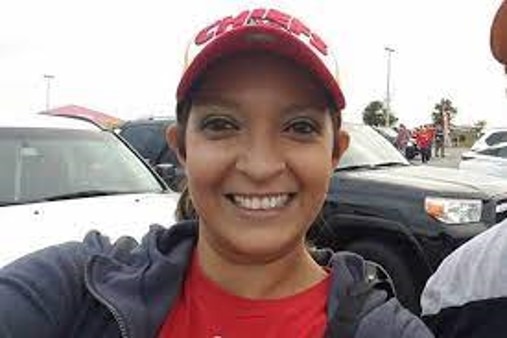
Bosch’s gun detection system, utilizing AI-enabled cameras that virtually recognize firearms as well as audibly recognizing gunshots. Thinking about this week’s tragic shootings in Kansas City at the Chiefs’ rally, perhaps these horrible incidents could be prevented or at least provide law enforcement with a jumpstart.
This one hit especially close to the radio community as the only confirmed death was community station KKFI host Lisa Lopez-Galvan (pictured), truly tragic loss. You can see how the AI technology that might prevent this type of crime works in this 1-minute video.
May we live in AInteresting times.
But watch the webinar for yourself. Chris’ list of AI innovations will be food for thought for your team as you consider how the technology applies to your company, cluster, or station. You can download it here.
So I encourage you to jump on this – as we have – while generative AI is still in the “early days” phase. Aside from saving money and increasing efficiency, the applications for day-to-day practical use are just beginning.
Sign up for our online newsletter – AI Edge – here. And let’s start talking it over.
You can email Chris here with questions, thoughts, and ideas. How can we make AI Edge as useful and relevant as possible as the landscape shifts? And how can we help you navigate it?
We are most certainly living in AInteresting times.
- What To Do If Your Radio Station Goes Through A Midlife Crisis - April 25, 2025
- A 2020 Lesson?It Could All Be Gone In A Flash - April 24, 2025
- How AI Can Give Radio Personalities More…PERSONALITY - April 23, 2025




Regarding sponsorships and specializations, there are indeed significant companies (or subsidiaries) that focus on newsletters–often for B2B purposes. Those include SmartBrief, Industry Dive, Axios, and Morning Brew. (SmartBrief is owned by Future, which likely explains why co-owned Radio World uses it.)
https://pressgazette.co.uk/media-audience-and-business-data/biggest-news-email-newsletter-publishers